Mexican Cartel Tactical Note #38: Armed Drone Targets the Baja California Public Safety Secretary’s Residence in Tecate, Mexico
John P. Sullivan, Robert J. Bunker and David A. Kuhn
On Tuesday, 10 July 2018, an armed drone targeted the residence of Gerardo Sosa Olachea, the public safety secretary/Secretario de Seguridad Pública Estalal (SSPE) of Baja California, in colonia Los Laureles in Tecate—a border city in the San Diego-Tijuana metropolitan area. A second drone, which may have been utilized for ISR (intelligence, surveillance and reconnaissance) and C2 purposes, was seen over the incident scene. At least one of the drones was equipped with a video camera link and was armed with two IEDs that did not detonate. For a number of international security professionals tracking cartel and gang violence in Mexico—including the authors of this note—an incident like this has been expected for some time now, given the earlier I&W (Indications & Warnings) event that took place in Guanajunto state in October 2017 when a weaponized drone was seized from Cártel de Jalisco Nueva Generación (CJNG) operatives.
Key Information: “Con drones envían granadas a casa de Sosa Olachea.” Zeta. 10 July 2018, http://zetatijuana.com/2018/07/con-drones-envian-granadas-a-casa-de-sosa-olachea/:
Pasadas las 07:00 horas del martes 10 de julio, dos drones fueron enviados a sobrevolar la casa del Secretario de Seguridad Pública de Baja California, Gerardo Sosa Olachea, ubicada en la colonia Los Laureles, en Tecate, en las inmediaciones de la carretera a Ensenada.
Poco antes de las 07:30 horas cuando testigos pudieron ver cuando los aparatos descendían sobre el inmueble, que en ese momento estaba ocupado por una persona que apoya a la familia con el aseo.
La base de la Policía Estatal Preventiva (PEP) recibió dos reportes al respecto, primero de los artefactos sobrevolando y el segundo indicando que en la casa de Sosa Olachea habían localizado por lo menos uno de los drones equipados con cámara y audio. En este aparato, sujetaron con cinta adhesiva dos granadas de fragmentación que no detonaron cuando los dejaron caer.
Key Information: “Reportan drones con granadas; uno descendió en la casa del titular de la SSP en BC.” Proceso. 10 July 2018, https://www.proceso.com.mx/542389/reportan-drones-con-granadas-uno-descendio-en-la-casa-del-titular-de-la-ssp-en-bc:
Los drones serán revisados por la Policía Cibernética de la SSP para conocer su origen y la ruta que siguieron hasta llegar al espacio aéreo de la casa de Sosa Olachea.
Pese a que los drones son de capacidad media y requieren que la persona que los maneja esté cerca del perímetro de vuelo, nadie fue aprehendido. Al parecer los agresores huyeron al momento de observar que las granadas no detonaron…
Sosa Olachea dijo al semanario Zeta que no ha recibido amenazas desde que tomó el cargo, en octubre de 2017, pero presume que el ataque pudo venir de los cárteles de las drogas “a los que les hemos pegado mucho con los decomisos, que más que grandes son constantes, del narcomenudeo, de los laboratorios localizados en Tecate y Rosario”.
Key Information: “Con Granadas Transportadas En Un Dron Atacan Casa De Secretario De Seguridad Pública De BC.” Reporte Indigo. 10 July 2018, https://www.reporteindigo.com/reporte/granadas-transportadas-en-dron-atacan-casa-secretario-seguridad-publica-bc/:
La madrugada de este martes dos granadas fueron colocadas en el interior de una de las casas del secretario de Seguridad Pública de Baja California, Gerardo Manuel Sosa Olachea.
Para lograr su cometido, los artífices del ataque utilizaron un dron en el que amarraron los artefactos explosivos para dejarlos caer en la propiedad, ubicada en el municipio de Tecate.
Key Information: Ángel F. González, “Señala SSPE a cárteles en atentado a secretario.” Frontera.info. 11 July 2018, http://www.frontera.info/EdicionEnLinea/Notas/Noticias/11072018/1355958-Senala-SSPE-a-carteles-en-atentado-a-secretario.html:
La vulnerabilidad
El hecho de que integrantes del crimen organizado dejaran un dispositivo con granadas de fragmentación en la casa del titular de la Secretaría de Seguridad Pública Estatal (SSPE) demuestra la vulnerabilidad en la que se encuentra la ciudadanía en Baja California, consideró el presidente del Consejo Ciudadano de Seguridad Pública, Juan Manuel Hernández Niebla.
“Cuando el crimen organizado pretende amenazar a un alto dirigente policiaco, refleja el grado de vulnerabilidad que tenemos los ciudadanos en Baja California”, dijo.
Tras el hallazgo del dron, añadió, es necesario que se descubra a los presuntos responsables para que las bandas del crimen organizado tengan en claro que esas acciones no quedarán impunes.
Key Information: “La amenaza.” Zeta, 16 July 2018, http://zetatijuana.com/2018/07/la-amenaza-3/.
El 10 de julio de 2018, sin más preámbulo y utilizando un dron, alguien sobrevoló el espacio aéreo de la residencia de Sosa en Tecate, e hizo descender el artefacto ahí mismo. Pegadas iban las que parecían ser dos granadas de fragmentación. Aunque inicialmente lo consideró un atentado, el caso terminó en una amenaza. En el dron había un mensaje con imágenes de cercanos al funcionario estatal…
Investigadores reiteraron que en Tecate solo existe una célula criminal “en control, pero se han pasado de un cártel a otro según les convenga, actualmente están con el Cártel Jalisco”…
Who: The attack was conducted by a criminal organization—a Mexican cartel—with the ability and willingness to engage in a tactical action in the contested Tecate segment of the Tijuana plaza against the senior ranking state law enforcement official. The dominant cartels operating in Baja California state are Cártel de Sinaloa (CDS) and remnants of the Tijuana Cartel/Cártel Arellano Félix (CAF) or Arellano-Félix Organization (AFO) which are in the process of reforming under the banner of the Cártel de Jalisco Nueva Generación (CJNG) as the Cártel de Tijuana Nueva Generación (CTNG). Considering past patterns of violence in the Tecate area and the broader Tijuana plaza—as well as in Baja California itself—this attack has a signature consistent with prior CTNG/CJNG activity and can likely be attributed to a CTNG/CJNG operational cell.
What: A weaponized drone attack targeting the residence (known as “La Quinta Marina”) of the public safety secretary of Baja California (Secretario de Seguridad Pública Estalal–SSPE) Gerardo Sosa Olachea. This is the first recorded incident in Mexico in which a weaponized cartel drone has both been used a) offensively and b) in a coordinated manner with a second mission support drone.
When: The attack took place at 0700-0730 on Tuesday 10 July 2018. The attack was timed while the Baja California public safety secretary was leaving his residence and getting into his vehicle in order to later meet with the new US Consul in Tijuana. According to the Editor-in-Chief of Zeta (the Tijuana news magazine), the timing of attack was closer to 0740.[1] The fact the public safety secretary was even at home at this time is in direct variance to an official Mexican governmental release that said the secretary what not a home at the time of the incident and actually lives in Mexicali (some 68.7 miles away).[2]
Where: The residence of the Secretario de Seguridad Pública Estalal (SSPE) of Baja California is located in Tecate, Mexico in the colonia Los Laureles subdivision and is well known to the local residents. This border city is 23.7 miles east of Tijuana in the San Diego-Tijuana metropolitan area and has a present population of approximately 75,000.
Why: Based on an ongoing pattern of earlier threats directed at lower level police officials by organized crime—specifically the CTNG/CJNG alliance—and the inoperability (render safe procedures) of the IEDs carried on the attacking drone, this incident can be viewed as a threat, a communication or ‘threat escalation’ meant to intimidate the public safety secretary of Baja California rather than an actual attack (or attack dry run) in which mission failure took place.
Analysis (Background)
Drones are increasingly a feature of the narco-conflict in the plazas (the narco-market controlled by a single cartel or gangs or contested among many seeking dominance) along the US-Mexico border.[3] As recently as late June, the Washington Post reported that illicit drone flights were surging.[4] Most narcodrones are used for intelligence, surveillance, and reconnaissance (ISR) or for light trafficking of contraband or drugs, however the potential for armed drone use by cartels and gangs has existed for several years. That potential was strongly confirmed in 20 October 2017 when Mexican Federal Police/Policía Federal (PF) in Guanajunto interdicted an improvised explosive drone—‘dron bomba’—consistent with potato bombs (papas bombas) used by the Cártel de Jalisco Nueva Generación (CJNG).[5]
Tecate, like much of the Tijuana plaza, is contested turf. The Sinaloa cartel, which gained dominance of the plaza after battling the Arellano-Félix Organization (AFO)/Cártel Arellano Félix (CAF) or Tijuana Cartel), is once again being challenged by remnants of the AFO known as the Cártel de Tijuana Nueva Generación (New Generation Tijuana Cartel) under the protection of the CJNG.[6] Indeed, the police have long been targeted in the narco-violence in this border city just south of San Diego. In addition to the drone attack on the home of SSPE secretary Sosa Olachea on Tuesday, 10 July 2018, a state ministerial police officer was injured in an armed attack at about 1800 hours on 29 June 2018. Witnesses said two suspects fired on the commander of the Policía Ministerial who repelled the attack while a uniformed officer was injured and transported to hospital.[7] In June 2017, a sicario working for the Cártel de Sinaloa was captured, tortured, sexually assaulted, and beheaded by suspected CJNG operatives. His head was left near the home of Tecate’s municipal public safety director along with a narcomensaje (narco message). The gruesome display was interpreted as a warning to the police director.[8]
Analysis (Technical Assessment)
Two drones targeted the home of SSPE secretary Gerardo Sosa Olachea in the Tecate neighborhood of colonia Los Laureles, in Tecate at approximately 0700-0730 hours (though this incident may have taken place as late as 0740). One of the drones landed on the property—known as “La Quinta Marina”—as the secretary was leaving for a meeting with the new Consul of the United States in Tijuana. According to multiple press reports, the devices on one of the drones failed to detonate and the area was cordoned by state preventive police/Policía Estatal Preventiva (PEP). At the time of this report, one of the drones and the devices it held will be undergoing forensic assessment by SEDENA (Secretaría de la Defensa Nacional). The cyber squad of the SSPE (Policía Cibernética) is also expected to examine the drone.[9] Images of this drone have been graciously provided courtesy of César R. Blanco Villalón, Editor-in-Chief, Zeta, for this tactical note.[10]
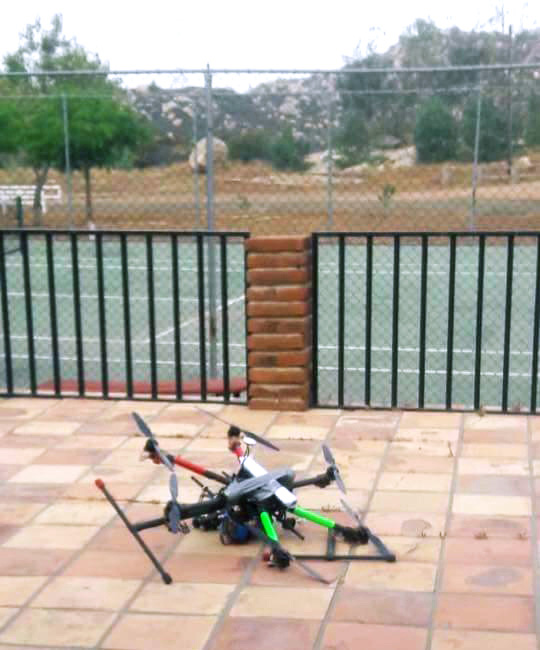
Attacking Tarot Ironman Drone Hard Landing in a Courtyard with Tennis Court in the Background; Carbon Fiber Landing Gear Leg Broken Off
Photograph 1: Courtesy of Zeta
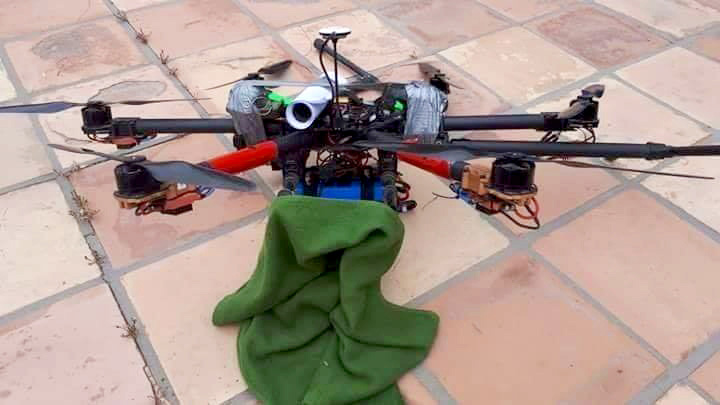
Close Up of Attacking Tarot Ironman Drone; Tactical Note Forensic Notations (Green Blanket—Post-Crash Placement—Probable Video Camera Feed Obscurement; 1st IED taped on the left-side; 2nd IED taped on the right-side; White Tube also taped to drone)
Photograph 2: Courtesy of Zeta
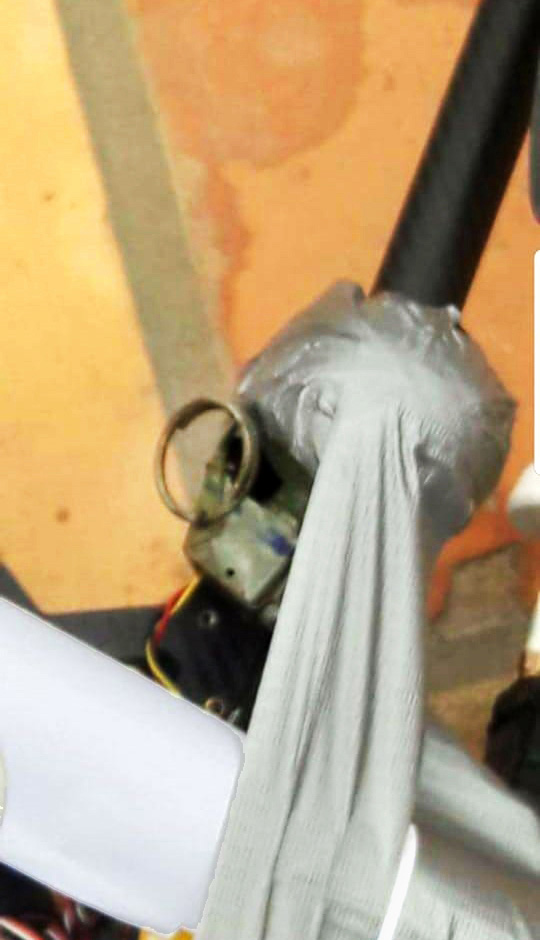
1st IED Taped to Frame
Photograph 3: Courtesy of Zeta
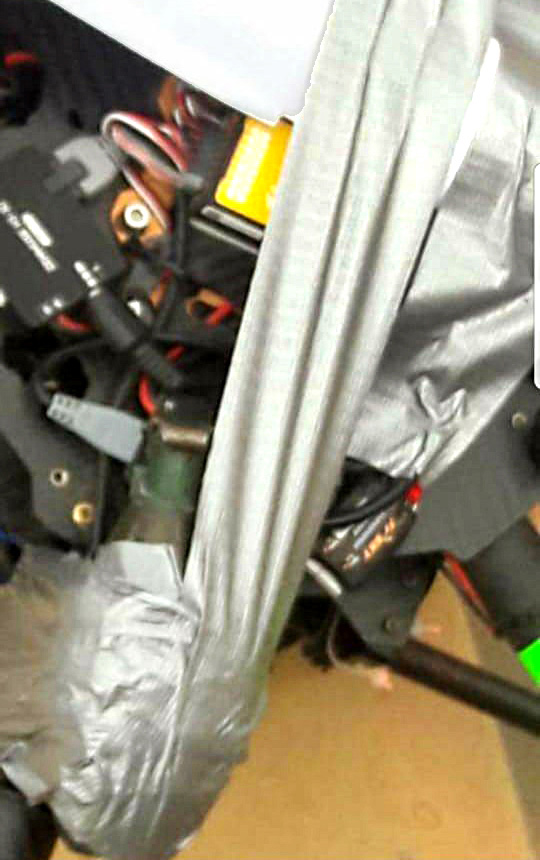
2nd IED Taped to the Frame
Photograph 4: Courtesy of Zeta
Various drone technical and incident TTP (tactics, techniques, and procedures) specifics have been determined concerning this incident. The drone in question made either a hard landing or was purposely put down hard by command signal in order to prevent any possibility of further movement (as the drone’s onboard radio link is still active) in the courtyard of the residence. Forensic imagery analysis of the drone provided by Brandon “Sas” Sasnett, Director of Threat Analysis, Red Six Solutions, LLC yields the following information:
Airframe: Tarot Ironman
Video System: DJI AVL58
Flight Controller: DJI Naza-M
Receiver: FrSky V8FR
Transmitter: Taranis (Compatible)
Maximum Flight Distance: Tecate Environment; Appx. 1.3 KM (0.8 miles)[11]
The drone—a hexacopter (i.e. configured with six rotors)—is kit based with the airframe and components manufactured by Tarot (Wenzhou, Zhejiang province, China; www.tarot-rc.com) but can be configured with other radio controlled hobbyist products. It carries a typical payload of 1.5 to 2.5kg (3.3 to 5.5 lbs) for the 680 pro series—and increasingly more for the later 810/960/1000 series. The drone may be of the X6 or 690 type but this is a speculative assumption only. The Tarot Ironman has a general flight speed of about 20-25 MPH, with the basic airframe retailing in the low-to-mid hundreds of dollars and the basic platform assembled to meet user needs. A fully configured drone, along with the flight controller system, can range anywhere from the high-hundreds of dollars into the low thousands, depending on whether it is built from scratch from parts or purchased as a completed unit. The landing gear of the drone was in the down position when it hard landed.
An analysis of the IEDs placed on the drone confirms that they were attached to two of the six frame arms and that a total of two different types of fragmentation hand grenades were utilized. The baseball style hand grenade is an M-67 fragmentation grenade (or a foreign copy thereof), and the second is a Chilean MK-2 fragmentation grenade. The M-67 (or similar copies) is relatively easy to obtain throughout Central and South America. The Chilean MK-2 is a close copy of the WWII and Korean era U.S. MK-2 grenades. This version was still in production and available as of 2002 from the manufacturer— Cardoen Industries (Industrias Cardoen), a South American defense company located in Piso, Santiago. It is important to note that this munition, although somewhat dated, is considered highly reliable if stored with minimal care.
The Chilean MK-2 grenade has several distinctive features that are not common to other MK-2 copies. The safety lever, for example, follows a European style that captures the top of the fuze housing by hooking over the top, as opposed to using a fork that hooks under a T-bar. Additionally, the fuze housing of the Chilean version flares to a lip at the base that protrudes past the truncated top of the grenade body. Both of these features can be observed in the highlighted areas in enhanced Photographs: 4 and 4A.
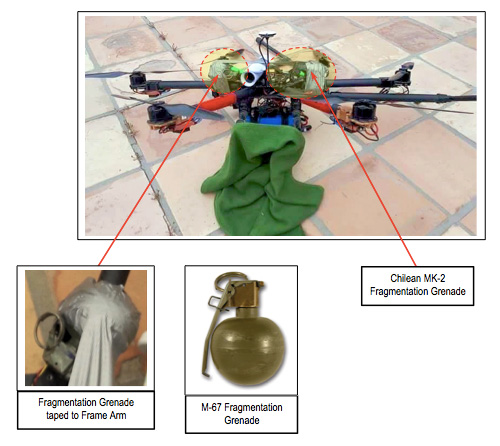
Additional Photograph 2 (& 3) Analysis with M-67 Fragmentation Grenade Identification (Original Photos Courtesy of Zeta)
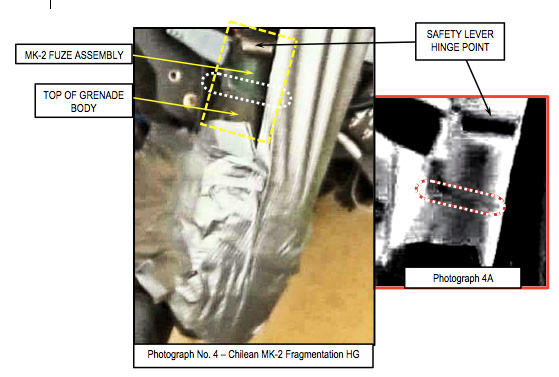
Additional Photograph 4 Analysis with 4A Imaging for MK-2 Grenade Identification
(Original Photo Courtesy of Zeta)
The two grenades that are attached to the La Quinta Marina drone have been secured to the frame arms with the safety pins in place. Based upon the forceful landing combined with the intact safety pins, it appears in all respects that the operators of the drone wanted to send a clear message to the resident that a fully armed drone of similar configuration could be sent at any time. It is also believed that the grenades aboard this drone are live, as inert ones would certainly not carry the same message impact.
The reader should note that, although the safety levers of both hand grenades were taped over in the process of securing the grenades to the drone, there are a number of methods by which the grenades (armed with pins removed) could be detonated either at low altitude or following a landing in a specific location. Due to reasons of security, these will not be addressed here. There are also drone configurations previously used by ISIS that allow explosive payloads to be released at altitude against a specific target.
Typically, two drones are used in any of the above attack methods. The second drone is used not only for spotting and documenting, but to assist the primary drone operator in establishing and maintaining correct flight orientation. The reader will note that the drone in the photograph has two of the six beam arms marked in green while the opposing two arms display red markings that allow the operator to verify forward and aft orientation for positive visual flight control from a distance.
The M-67 fragmentation grenade contains a filler of 184.6 gm. of Composition “B” explosive and has a casualty radius of 15-meters. The Chilean Mk-2 contains a 115gm. explosive filler that is believed to be either flaked TNT or Composition “B.” This grenade has a similar casualty radius, although not as efficient in shrapnel dispersal as the M-67.
The total combined weight of the two grenades is 1,052 grams (2.32 lbs.). This is well under the 5 kg. (11 lb.) payload capability of later 690S or X6 series and still within the normal payload parameters of the earlier 680 pro series.[12]
The white tube—composed either of rolled cardboard or plastic—which was taped to the top of the drone (refer to Photographs 1 & 2) was said to supposedly contain a narco message (narcomensaje) and pictures of Gerardo Sosa Olachea’s family members taken from their private Facebook accounts.[13] This information, as well as the physical fact that the IEDs were rendered inoperable, leads credence to the ‘threat escalation’ hypothesis endorsed in this tactical note.
The operational cell engaged in this mission was likely composed of at least five individuals—two drone pilots, a driver, and two dedicated security—and one transport vehicle such as an SUV, though for coordination purposes ground surveillance of the targeted primary residence would be utilized as well as neighborhood lookouts (halcones) deployed to provide early warning of approaching police patrols. Given the limitations of the drones utilized—which possesses roughly 20 minute flight times—an operational window of only about 10-15 minutes existed, as launch and recovery windows would also have to be taken into consideration. This would necessitate a launch point within a quarter to half a mile (0.25-0.50 miles) of the residence rather than at maximum flight distances (0.8 miles) to better ensure operational success. Further characterization of this suspected operational cell, once again due to security considerations, will not be provided.
Conclusion
While the intent of the attackers is unknown at this time (SEDENA, the SSPE, and PEP have not disclosed the identity of the suspected criminal organization pending further investigation), it is highly probable that the attack was a demonstration of intent or a warning to the SSPE secretary as seen in the CJNG warning to the Tecate police director in late June 2017.[14] Potential actors behind the attack/threat include 1) state police working for narcos; 2) local criminals from Tecate; 3) huachicoleros (fuel thieves); 4) narcomenudistas (street drug dealers); and 5) narco cartels (cárteles de la droga) including the CJNG, Cártel de Sinaloa (CDS), or Cártel Arellano Félix (CAF). The Tecate area is currently assessed to be dominated by the CJNG, that is, local criminal organizations, such as the Los Enfermos, Los Hemanos Valdez, and La Bondad currently owe allegiance to capos under the CJNG umbrella.[15] This territorial control combined with prior CJNG targeting and drone potentials make s the CJNG the likely author of this attack/threat demonstration.
While it is possible that the device(s) failed and the attackers intended direct harm or even that a dry run was being engaged in with the weaponized drone simulating an attack crashing to the ground, the IED safety protocols utilized and threatening note to Gerardo Sosa Olachea, accompanied by photos of his family, definitely suggest otherwise. This attack is significant in the direct targeting of a state police official by a criminal organization in a contested plaza.
This incident should be considered an escalation of cartel/gang drone use and certainly won’t be the last use of armed drones in Mexico’s crime wars or by terrorists and/or insurgents elsewhere.[16] Indeed, as we complete this assessment, a drone attack on 4 August 2018 in Caracas characterized as an attempted assassination on Venezuelan President Nicolas Maduro dominates the news.[16] The effectiveness of these future drone attacks is expected to vary—indeed most can be expected to inflict limited damage—however over time the threat will likely mature, yielding enhanced lethality and operational effectiveness.[18] Further, from a homeland security perspective, this incident represents the first confirmed offensive use of a weaponized cartel drone in Mexico—one taking place only a few miles below the US-Mexico border.
Significance: Cártel de Jalisco Nueva Generación; CJNG Links (Potentials), Cartel Technology, Drones, Improvised Explosive Devices (IEDs), Narcodrones, Tactics, Techniques, and Procedures (TTPs), Weaponized Drones, Weaponized Unmanned Aerial System (UAS)
Incident overview, I&W, and past narco drone use analysis conducted by John P. Sullivan and Robert J. Bunker. Drone IED forensics and analysis conducted by David A. Kuhn.
Sources
“La amenaza.” Zeta. 16 July 2018, http://zetatijuana.com/2018/07/la-amenaza-3/.
Ángel F. González, “Señala SSPE a cárteles en atentado a secretario.” Frontera.info. 11 July 2018, http://www.frontera.info/EdicionEnLinea/Notas/Noticias/11072018/1355958-Senala-SSPE-a-carteles-en-atentado-a-secretario.html.
“Con drones envían granadas a casa de Sosa Olachea.” Zeta. 10 July 2018, http://zetatijuana.com/2018/07/con-drones-envian-granadas-a-casa-de-sosa-olachea/.
“Con Granadas Transportadas En Un Dron Atacan Casa De Secretario De Seguridad Pública De BC.” Reporte Indigo. 10 July 2018, https://www.reporteindigo.com/reporte/granadas-transportadas-en-dron-atacan-casa-secretario-seguridad-publica-bc/.
“Desconocidos pegan granadas a dron y las hacen caer en casa del Secretario de Seguridad Pública de BC.” Sin Embargo. 10 July 2018, http://www.sinembargo.mx/10-07-2018/3440637.
José Jiménez Díaz, “No detona dron con granadas en casa de Sosa Olachea.” El Mexicano. 10 July 2018, http://www.el-mexicano.com.mx/informacion/noticias/1/3/estatal/2018/07/10/1052433/no-detona-dron-con-granadas-en-casa-de-sosa-olachea.
“Reportan drones con granadas; uno descendió en la casa del titular de la SSP en BC.” Proceso. 10 July 2018, https://www.proceso.com.mx/542389/reportan-drones-con-granadas-uno-descendio-en-la-casa-del-titular-de-la-ssp-en-bc.
End Notes
[1] Robert J. Bunker email correspondence with César R. Blanco Villalón, Editor-in-Chief, Zeta, on 13 July 2018. The new Council of the United States in Tijuana is Sue Saarnio. See https://mx.usembassy.gov/embassy-consulates/tijuana/consul-general-sue-saarnio/.
[2] “Drone with grenades falls into official’s residence.” Imperial Valley Press. 11 July 2018, https://www.pressreader.com/usa/imperial-valley-press/20180711/281582356394974.
[3] See Robert J. Bunker, “Mexican Cartel Tactical Note #21: Cartel Unmanned Aerial Vehicles (UAVs).” Small Wars Journal. 1 August 2014, http://smallwarsjournal.com/blog/mexican-cartel-tactical-note-21; John P. Sullivan and Robert J. Bunker, “Mexican Cartel Strategic Note No. 18: Narcodrones on the Border and Beyond.” Small Wars Journal. 28 March 2016,
http://smallwarsjournal.com/jrnl/art/mexican-cartel-strategic-note-no-18-narcodrones-on-the-border-and-beyond; and Aaron R. Schmershi, Fifty feet above the wall: cartel drones in the U.S.-Mexico border zone airspace, and what to do about them. Masters Thesis. Monterey: Naval Postgraduate School, 2018, http://hdl.handle.net/10945/58364.
[4] Gina Harkins, “Illicit drone flights surge along U.S.-Mexico border as smugglers hunt for soft spots.” Washington Post. 24 June 2018, https://www.washingtonpost.com/world/national-security/illicit-drone-flights-surge-along-us-mexico-border-as-smugglers-hunt-for-soft-spots/2018/06/24/ea353d2a-70aa-11e8-bd50-b80389a4e569_story.html?utm_term=.0992752ea810.
[5] Robert J. Bunker and John P. Sullivan, “Mexican Cartel Tactical Note #35: Weaponized Drone/UAV/UAS Seized in Valtierrilla, Guanajuato with Remote Detonation IED (‘Papa Bomba’) Payload.” Small Wars Journal. 23 October 2017, http://smallwarsjournal.com/jrnl/art/mexican-cartel-tactical-note-35.
[6] “El Cártel de Sinaloa y el Cártel Jalisco Nueva Generación se pelean por la plaza de Tecate” in “El narco amenaza al gobierno en Tecate, Baja California.” El Debate. 28 September 2016, https://www.debate.com.mx/policiacas/El-narco-amenaza-al-gobierno-en-Tecate-Baja-California-20160928-0223.html; “Tijuana, territorio en disputa por el CJNG y el Cártel de Sinaloa.” El Financiero. 25 February 2018, http://www.elfinanciero.com.mx/nacional/el-cartel-de-jalisco-nueva-generacion-intenta-arrebatarle-tijuana-al-cartel-de-sinaloa; and “Recrudece violencia Cártel Jalisco.” Zeta, 18 June 2018, http://zetatijuana.com/2018/06/recrudece-violencia-cartel-jalisco/.
[7] “Atentan contra Comandante de la Ministerial en Tecate; huyen a Tijuana.” Uniradio Informa, 29 June 2018, http://www.uniradioinforma.com/noticias/policiaca/530043/atentan-contra-comandante-de-la-ministerial-en-tecate-huyen-a-tijuana.html and Kathia Borbolla, “Balean a policía ministerial en Tecate.” El Debate, 20 June 2018, https://www.debate.com.mx/policiacas/policia-ministerial-baleado-ataque-armado-comandante-tecate--20180630-0059.html.
[8] Carlos Lima and Esther Hernández. “Abandonan cabeza cerca de casa del jefe de Policía de Tecate.” Frontera.info. 6 October 2017, http://www.frontera.info/EdicionEnLinea/Notas/Noticias/10062017/1224350-Abandonan-cabeza-cerca-de-casa-del-jefe-de-Policia-de-Tecate.html and “Cae cabeza del CJNG en Tecate.” Zeta. 26 June 2017, http://zetatijuana.com/2017/06/cae-cabeza-del-cjng-en-tecate/.
[9] See the Key Information entries and sources listed in the text for specific references.
[10] César R. Blanco Villalón, Editor-in-Chief, Zeta, email correspondence with Robert J. Bunker on 13 July 2018.
[11] Brandon “Sas” Sasnett, Director of Threat Analysis, Red Six Solutions, LLC email correspondence with Robert J. Bunker on 10 July 2018.
[12] It should be noted that the continued advent of higher technology drones entering the world market that are capable of higher payloads, longer flight times, and increased guidance capability will prove a continuing and significant threat when placed in use by terrorists and now narco-terrorists and criminal insurgents.
[13] César R. Blanco Villalón, Editor-in-Chief, Zeta, email correspondence with Robert J. Bunker on 13 July 2018. Additionally, in this correspondence it was independently confirmed that, “The grenades were manipulated, they didn’t have the capacity to blow up.”
[14] Ibid, Note 8.
[15] “Investigadores reiteraron que en Tecate solo existe una célula criminal “en control, pero se han pasado de un cártel a otro según les convenga, actualmente están con el Cártel Jalisco” at “La amenaza.” Zeta, 16 July 2018, http://zetatijuana.com/2018/07/la-amenaza-3/.
[16] See Colin P. Clarke, “A Terrorist's Dream: How Twitter and Toy Drones Could Kill a Lot of People.” The National Interest. 17 June 2018, https://nationalinterest.org/blog/the-buzz/terrorists-dream-how-twitter-toy-drones-could-kill-lot-26288?nopaging=1.
[17] Alexandra Ulmer and Vivian Sequera, “Venezuela's Maduro says drone blast was bid to kill him, blames Colombia,” Reuters Venezuela. 4 August 2018, https://www.reuters.com/article/us-venezuela-politics/venezuelas-maduro-target-of-drone-attack-but-unharmed-government-idUSKBN1KP0SA; Scott Smith and Christine Armario, “Venezuela’s Maduro: Drone attack was attempt to kill him.” Washington Post. 4 August 2018, https://www.washingtonpost.com/world/the_americas/venezuelan-government-drone-strikes-targeted-maduro/2018/08/04/01034d9a-9846-11e8-818b-e9b7348cd87d_story.html?utm_term=.b55612dac292; and Ana Vanessa Herrero and Nicholas Casey, “Venezuelan President Targeted by Drone Attack, Officials Say.” New York Times. 4 August 2018, https://www.nytimes.com/2018/08/04/world/americas/venezuelan-president-targeted-in-attack-attempt-minister-says.html.
[18] See Scott Stewart, “When Drones Attack: The Threat Remains Limited.” Stratfor Worldview. 17 July 2018, https://worldview.stratfor.com/article/when-drones-attack-threat-remains-limited.
For Additional Reading
Robert J. Bunker and John P. Sullivan, “Mexican Cartel Tactical Note #35: Weaponized Drone/UAV/UAS Seized in Valtierrilla, Guanajuato with Remote Detonation IED (‘Papa Bomba’) Payload.” Small Wars Journal. 23 October 2017, http://smallwarsjournal.com/jrnl/art/mexican-cartel-tactical-note-35.
John P. Sullivan and Robert J. Bunker, “Mexican Cartel Strategic Note No. 18: Narcodrones on the Border and Beyond.” Small Wars Journal. 28 March 2016,
Robert J. Bunker, Terrorist and Insurgent Unmanned Aerial Vehicles: Use, Potentials, and Military Implications. Carlisle Barracks: Strategic Studies Institute, U.S. Army War College. 27 August 2015, https://ssi.armywarcollege.edu/pubs/display.cfm?pubID=1287.
Robert J. Bunker, “Mexican Cartel Tactical Note #21: Cartel Unmanned Aerial Vehicles (UAVs).” Small Wars Journal. 1 August 2014, http://smallwarsjournal.com/blog/mexican-cartel-tactical-note-21.


